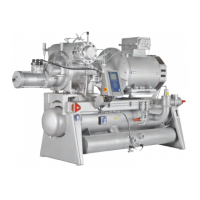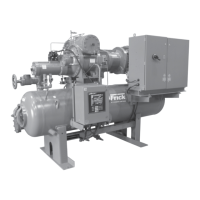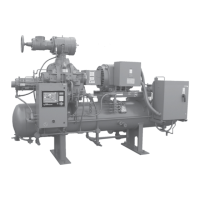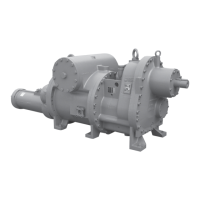Engineering manual - SAB 193-233-283 S A-frame (including ATEX)
32/168
008831 en 2020.10
Safety precautions
Furthermore, it can be said about refrigerants:
HFC/HCFC
If released into the atmosphere, halogenated refrigerants of the types CFC and HCFC (e.g. R22)
will contribute to the depletion of the ozone layer in the stratosphere. The ozone layer protects
the earth from the ultraviolet rays of the sun. Refrigerants of the types CFC, HFC and HCFC are
greenhouse gases which contribute to an intensification of the greenhouse effect. They must,
therefore, never be released into the atmosphere. Use a separate compressor to draw the refrig-
erant into the plant condenser/receiver or into separate refrigerant cylinders.
Ammonia
• Ammonia is easily absorbed by water: At 15°C 1 litre of water can absorb approx. 0.5 kg
liquid ammonia (or approx. 700 litres ammonia vapour).
• Even small amounts of ammonia in water (2-5 mg per litre) are enough to wreak havoc
with marine life if allowed to pollute waterways and lakes.
• As ammonia is alkaline, it will damage plant life if released into the atmosphere in large
quantities.
Hydro carbons (HC)
• HC gases are a group of B1 refrigerants characterised as very flammable.
• Hydro carbons are odourless and non-toxic gases. Specific mixtures of air and gas create
danger of explosion. As the gases are heavier than air, they will be concentrated at the
lowest possible level in case of leaks.
Carbon dioxide (CO
2
)
• Carbon dioxide (CO
2
) is a greenhouse gas with a GWP (Global Warming Potential) factor
of 1. It is found in the atmosphere in a concentration of 0.036 vol. % (360 parts per mil-
lion, ppm). As CO
2
is extracted from atmospheric air, it can safely be released into the at-
mosphere and does not contribute to enhancing the greenhouse effect.
• At atmospheric pressure, solid CO
2
(dry ice) at the temperature -78.5°C will not melt like
ordinary water ice. Instead it will evaporate and turn into gaseous state CO
2
, (substances
transitioning directly from the solid to the gaseous state are said to sublime).
• CO
2
is an odourless, non-toxic non-inflammable gas. The limit value for CO
2
is 5000 ppm.
The gas is heavier than air and will thus be concentrated at the lowest level of the room in
case of a leak. In closed rooms the gas can displace oxygen and cause suffocation.
Refrigerant evacuated from a refrigeration plant must be charged into refrigerant cylinders in-
tended for this specific refrigerant. This does not apply to CO
2
, however.
CO
2
must under no circumstances be collected in bottles as there is a risk of overfill. At worst, this
may cause the bottles to explode because of the rise in pressure.
If the refrigerant is not to be reused, return it to the supplier or to an authorised incineration
plant.
Halogenated refrigerants must never be mixed. Nor must R717 ever be mixed with halogenated
refrigerants.
Cooling media
Salt solutions (brines) of calcium chloride (CaCl
2
) or sodium chloride (NaCl) are often used.
In recent years alcohol, glycol and halogenated compounds have been used in the production of
brine.

